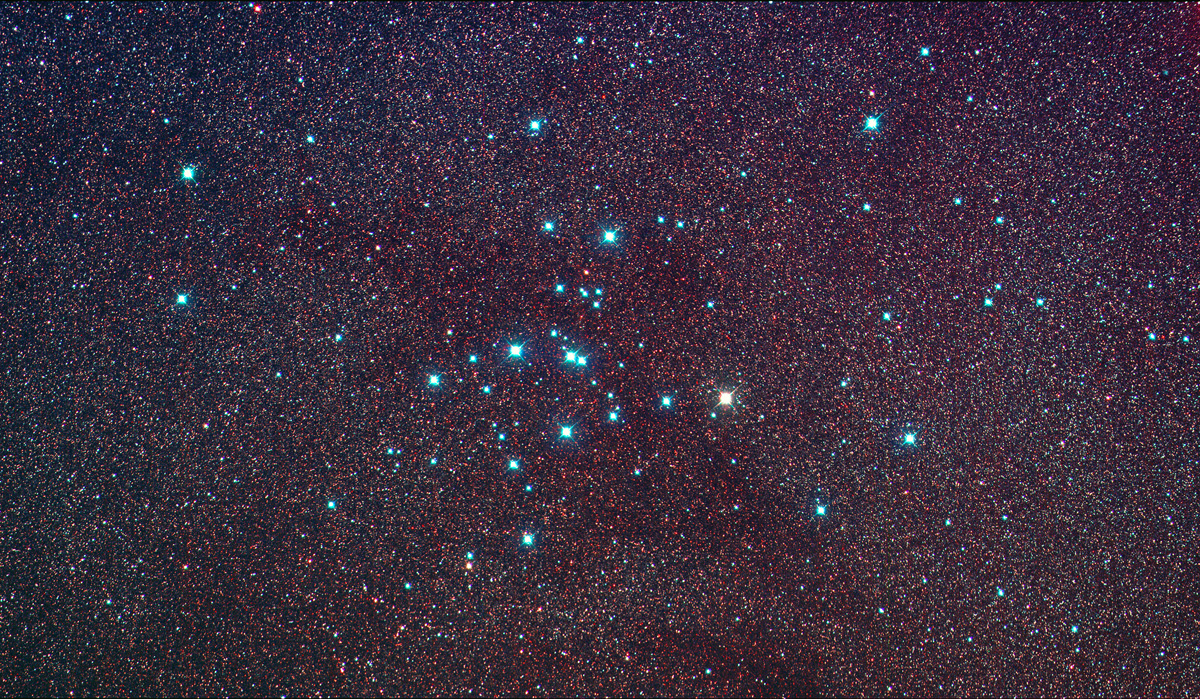

|
Type II2r |
|
5' |
|
(c) 2005 All astro photo images are copyrighted. They may not be used or reproduced without explicit written permission from the authors.
About this Image / Über dieses Bild
| CCD: | Fleischmann 7kx4k CCD |
| Image Type, Orientation: | LRGB Composite, North is at 10:30 |
| Exposure time: | L: 5x900 sec. 1x1 bin, R,G,B: 2x900 sec.2x2 bin |
| Exposure date: | May 5th, 2005 |
| Location: | Capella Observatory at Amani Lodge, Kupferberg near Windhoek, Namibia |
| Filter: | "Self made" filter slider with Astronomik Typ II L for luminance and Schott RG630, GG495+BG42 and BG25 for RGB. |
| Instrument: | Ganymed 60cm-Hypergraph in secondary focus, f=4800 mm |
| Image seeing (FWHM): | 2.7" |
| Photographer: | Josef Pöpsel, Beate Behle |
| Remarks: |
If you would take a look at the original resolution of this picture (28 millon pixels) about 300.000 stars can be detected. The field of view of the camera is about 59' times 39' at a focal length of 4800 mm. Estimating the size of the milky way in the sky at 20° times 360° and assuming, that the image above represents the medium star density of the milky way (what is not completely correct ;-)), the total number of stars in the milky way would amount to about 6 thousand million. In reality the number is 10...100 times bigger. The reason for this difference is, that the exposure time was not long enough to show all the dim stars in the field. One second reason is, that a resolution of 0.5"² even at best seeing conditions is not high enough to seperate all stars. How much the galactic dust influences the exposure can not be determined in an easy way. But the dust influence might not be so high, because the image was done pointing into the galactic halo and not into the central disk. Some "stars" got our attraction looked a bit different than all the others. Some of these have already been identified as planetary nebulae, some others should be observed more detailed in the future to detect their real nature. An image, where the unusual "stars" are marked, can be found here.
Here the key for the markers in the image:
1 + 4: Possibly two yet unknown PNs. In the Strasbourg-ESO Catalogue of Galactic Planetary Nebulae
nothing is marked for their positions - even not in the lists "Summery of True, Possible and Rejected PNs".
Some more informations about the used CCD camera can be found at the remarks to Omega Centauri. Although the sensitivity of the camera is very low it certainly could be used for a survey of big star fields searching for extrasolar planets using the transit or microlensing method.
The image was enhanced using CCD-Sharp. |
|
|
|
| Bemerkungen: |
Auf dem Bild sind in der Originalauflösung (28 Megapixel) ca. 300000 Sterne erkennbar. Das Gesichtsfeld der Kamera beträgt bei 4800mm Brennweite ca. 59' x 39'. Schätzt man die Ausdehnung der Milchstraße am Himmel mit 20° x 360° ab und nimmt weiterhin an, dass die Aufnahme oben eine mittlere Sterndichte der Milchstraße repräsentiert (was nicht ganz stimmt ;-)) , so erhält man als Gesamtzahl der Milchstraße ca. 6 Milliarden Sterne. Tatsächlich liegt diese aber um ein- bis zwei Zehnerpotenzen höher - ein eindeutiges Zeichen dafür, dass die Aufnahme nicht tief genug ist, um alle Sterne der Milchstraße in diesem Gesichtsfeld zu erfassen, und dass eine Auflösung von 0.5"² pro Pixel selbst bei bestem Seeing nicht ausreichen würde, um alle Sterne zu trennen. Wie viel Einfluss der galaktische Staub auf die Aufnahme hat, ist schlecht abzuschätzen. Er wird aber, da in Richtung galaktischem Halo und nicht in Richtung zentrale Scheibe photographiert wurde, nicht so hoch sein. Im Bild fielen einige "Sterne" auf, die etwas anders aussahen, als der Rest. Einige davon konnten eindeutig als planetarische Nebel identifiziert werden, andere müssten zukünftig genauer untersucht werden, um ihrer Natur auf den Grund zu gehen. Ein Bild, in dem die uns aufgefallenen "Sterne" markiert sind, befindet sich hier. Hier die Legende zu den Markierungen im Bild:
1 + 4: Möglicherweise zwei bisher nicht bekannte PNs. Im
Strasbourg-ESO Catalogue of Galactic Planetary Nebulae ist auch in der Liste
„Summery of True, Possible and Rejected PN“ an diesen Positionen nichts
verzeichnet. Einige weitere Informationen
zur eingesetzten CCD-Kamera sind bei den Bemerkungen zu
Omega Centauri
zu finden. Trotz der sehr geringen Empfindlichkeit der Kamera könnte sie
sicher gut zur Durchmusterung von großen Sternfeldern auf der Suche nach
extrasolaren Planeten nach der Transit- oder Microlensing-Methode dienen...
Das Bild wurde mit Hilfe von CCDSharp bearbeitet. |
Back to the Open Clusters Overview / Zurück zur Offene-Sternhaufen-Übersichtsseite